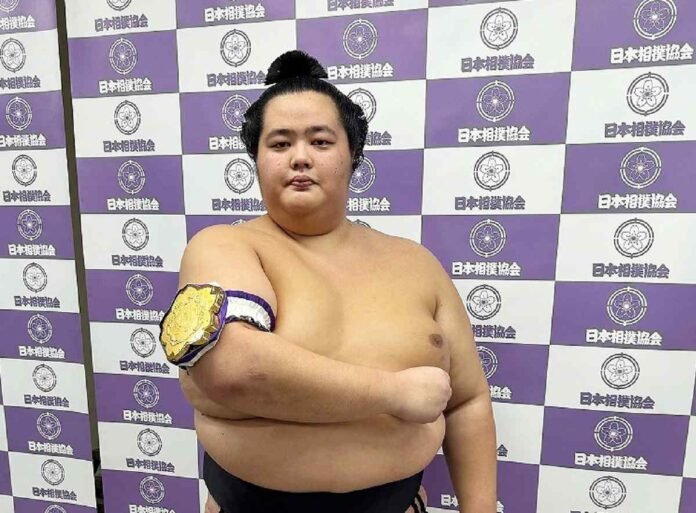Ozeki Kotozakura shows off the bracelet he received for winning the All-Japan Sumo Wrestlers Competition on September 30 at Ryogoku Kokugikan in Tokyo.
12:48 JST, October 16, 2024
The sport of sumo, which occupies such a prominent place in traditional Japanese culture, also has a strong connection with Shintoism.
On the day before the start of a major tournament, the head referee, dressed in the robes of a Shinto priest, performs a Shinto ritual. The yokozuna performs his entrance ceremony while wearing a thick, braided rope around his waist similar to the sacred ‘shimenawa’ rope displayed during the New Year holidays and on other occasions.
Against such a historical backdrop, ritual competitions known as ‘hono sumo’ are held across the country in association with major shrines.
The Meiji Jingu Shrine in Tokyo has a particularly deep relationship with the Japan Sumo Association. When a wrestler is promoted to the elite rank of Yokozuna, it is Meiji Jingu where a special ceremony is held to mark the occasion. Later, the new yokozuna famously performs his first ring-entry ceremony in the plaza in front of the main hall of the shrine.
Every year after the Autumn Grand Tournament, an event called the “All-Japan Sumo Wrestlers Competition” is held at Ryogoku Kokugikan in Tokyo, in celebration of the Meiji Jingu Autumn Grand Festival. The event has a long history and has earned the title of sumo’s oldest tournament in Japan.
The event was launched in 1925 during the Taisho era (1912-1926). It has been canceled a number of times due to war or other reasons, so this year’s tournament on September 30 was the 81st. Although the title is translated as ‘competition’ in Japanese, the character for ‘samurai’ (which is also the ‘shi’ in ‘rikishi’ or sumo wrestler) is used to imply that the participants are more than just ordinary athletes, thus it has a deeper meaning.
At the opening tournament, the 27th yokozuna Tochigiyama, who had just retired, made a special appearance. It is said that he defeated the active yokozuna to win the title, adding an anecdote to sumo history that seems unthinkable today.
Looking at a list of past champions, we see some of the biggest names in the history of the sport, from Futabayama to Taiho, from Kitanoumi to Chiyonofuji. Adding his name to such a prestigious company was the champion of this year’s tournament, Ozeki Kotozakura. With the absence of the injured yokozuna Terunofuji, Kotozakura was the highest ranked wrestler in the field and lived up to expectations by defeating the newly promoted Ozeki Onosato in the finals.
Ironically, Kotozakura’s grandfather – a yokozuna who was the original Kotozakura – never won the tournament. While the current Kotozakura wore the armband with a chrysanthemum emblem awarded to the champion on his right bicep, he said cheerfully: “I am happy that I could add the name Kotozakura [to the champions’ list].”
The win came in the wake of a lackluster 8-7 record in the fall tournament. “I hope this will lead to success at the next big tournament,” he said.
I hope Kotozakura has gotten a sense of the sanctity created by the event’s long history and comes back strong at the Kyushu Grand Tournament.
— Kamimura is a sumo expert.



